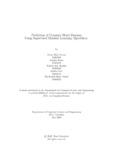| dc.contributor.advisor | Choudhury, Najeefa Nikhat | |
| dc.contributor.advisor | Hawlader, Ahanaf Hassan | |
| dc.contributor.author | Salam, Nazia Binte | |
| dc.contributor.author | Raisa, Samiha | |
| dc.contributor.author | Rashid, Rahela Atia | |
| dc.contributor.author | Noor, Asmita | |
| dc.contributor.author | Obaed, Sin-Sumbil Binte | |
| dc.date.accessioned | 2023-07-10T06:10:32Z | |
| dc.date.available | 2023-07-10T06:10:32Z | |
| dc.date.copyright | 2022 | |
| dc.date.issued | 2022-05 | |
| dc.identifier.issn | ID 18301080 | |
| dc.identifier.other | ID 18301156 | |
| dc.identifier.other | ID 18301150 | |
| dc.identifier.other | ID 19101640 | |
| dc.identifier.other | ID 18301092 | |
| dc.identifier.uri | http://hdl.handle.net/10361/18702 | |
| dc.description | This thesis is submitted in partial fulfillment of the requirements for the degree of Bachelor of Science in Computer Science, 2022. | en_US |
| dc.description | Cataloged from PDF version of thesis. | |
| dc.description | Includes bibliographical references (pages 31-33). | |
| dc.description.abstract | Cardiovascular disease is a leading cause of death worldwide. According to the Centers
for Disease Control and Prevention, one person dies from heart disease every 36
seconds in the United States. In 2019, an estimated 17.9 million people died from
CVD worldwide. High blood pressure, an unhealthy diet, high cholesterol, diabetes,
air pollution, obesity, tobacco use, kidney disease, physical inactivity, harmful alcohol
use, and stress can all contribute to it. Family history, ethnic background,
sex, and age are some other contributing factors to a person’s risk of heart disease.
This paper seeks to predict heart diseases using a dataset that has factors like age,
sex, the number of cigarettes smoked, etc. This prediction will be done by analyzing
different parameters like blood pressure, oxygen level, hemoglobin count, etc.
which are the major deciding factors to measure heart risks. The research will use
supervised Machine Learning (ML) algorithms such as decision tree (a classification
algorithm that works on categorical as well as numerical data), K-Nearest Neighbor
(K-NN), Random forest algorithm, etc. to provide an accurate prediction. After
applying ML on medical data, the outcome will be used to conduct a comparative
analysis to measure the efficiency of different ML algorithms in predicting cardiovascular
diseases. Furthermore, the major objective of this research is to use the
algorithms and process in Bangladeshi dataset and explore the result outcome and
newer possibilities. | en_US |
| dc.description.statementofresponsibility | Nazia Binte Salam | |
| dc.description.statementofresponsibility | Samiha Raisa | |
| dc.description.statementofresponsibility | Rahela Atia Rashid | |
| dc.description.statementofresponsibility | Asmita Noor | |
| dc.description.statementofresponsibility | Sin-Sumbil Binte Obaed | |
| dc.format.extent | 33 pages | |
| dc.language.iso | en | en_US |
| dc.publisher | Brac University | en_US |
| dc.rights | Brac University theses are protected by copyright. They may be viewed from this source for any purpose, but reproduction or distribution in any format is prohibited without written permission. | |
| dc.subject | Cardiovascular disease | en_US |
| dc.subject | Random forest algorithm | en_US |
| dc.subject | K-NN | en_US |
| dc.subject.lcsh | Machine learning | |
| dc.subject.lcsh | Computer algorithms | |
| dc.title | Prediction of coronary heart diseases using supervised machine learning algorithms | en_US |
| dc.type | Thesis | en_US |
| dc.contributor.department | Department of Computer Science and Engineering, Brac University | |
| dc.description.degree | B. Computer Science | |

